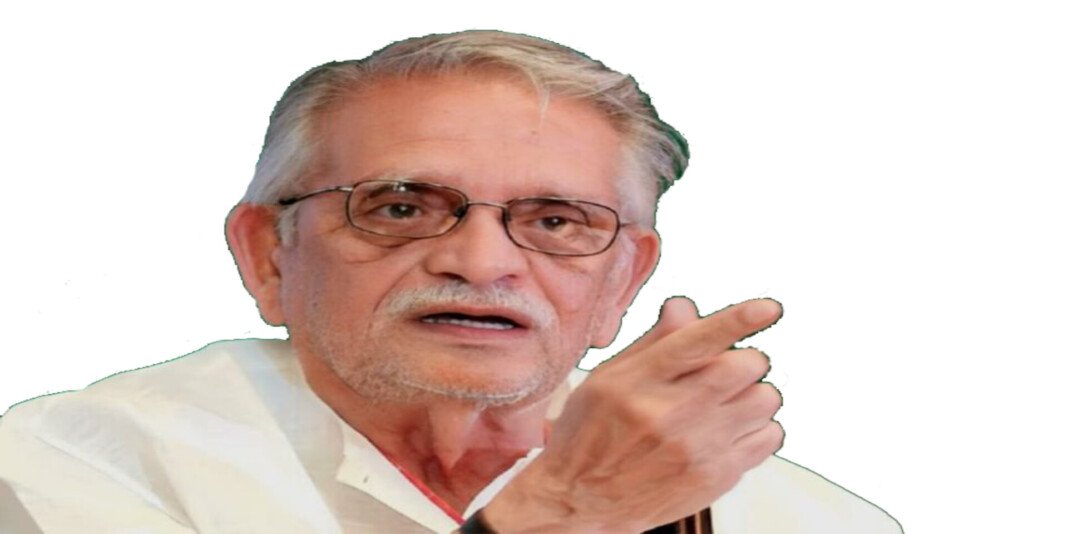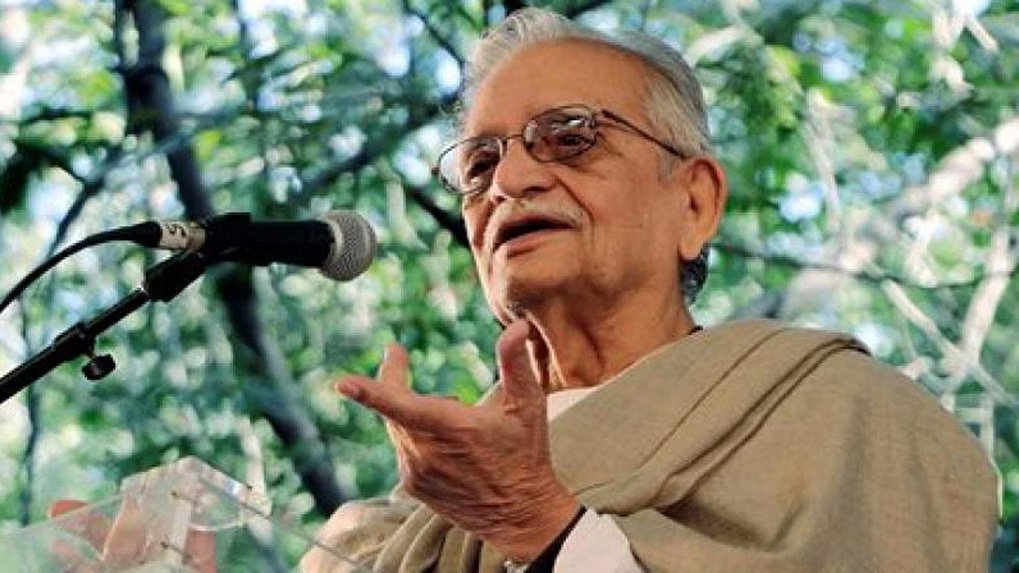By: Dipak Kurmi
While many are acquainted with Gulzar’s enchanting film lyrics dating back to the 1960s, his literary endeavors often remain in the shadows, distinct from his cinematic contributions. However, for devoted Gulzar enthusiasts, there’s exciting news – the eminent poet has been bestowed with the prestigious Jnanpith Award for the year 2023.
Every poet, in essence, is a trailblazer, a creator of new realms of thought. The seemingly ordinary titles of Gulzar’s poems, such as ‘Waqt,’ ‘Khuda,’ ‘Aansu,’ ‘Dariya,’ ‘Painting,’ ‘Baadal,’ ‘Raat,’ ‘Sketch,’ ‘Guftgu,’ ‘Post-Box,’ unveil a profound truth – his innovation lies in perceiving places, objects, and people through a fresh lens, offering novel interpretations with an array of words that prompt us to contemplate differently. Gulzar invites us on an expedition to unexplored mental landscapes, and upon return, we find ourselves pondering why we hadn’t embarked on such contemplation earlier. This essence of Gulzar’s poetic prowess radiates brightly each time his pen graces the paper.
Gulzar’s poem ‘Dastak’ resonates with an eerie power, etching an unforgettable impression on those who delve into its verses. Set against the backdrop of a disrupted dream, the poem unfolds with the unsettling tapping at the door in the dead of night, emanating from unseen visitors across the border. Embracing them into his abode, the poet extends the timeless embrace of Punjabi hospitality, a testament to enduring bonds that transcend geopolitical boundaries. A symbolic gift, the jaggery (gur) presented by the guests holds profound meaning, symbolizing the sweetness of friendships forged in the abundant harvests of bygone years, now marred by the scars of Partition and conflict. Yet, in the poignant moment of reunion, the dream is shattered abruptly, like glass, as the disquieting news of gunfire at the border pierces the tranquility of the night.
Dastak
Subah subah ik khwaab ki dastak par
darwaza khola, dekha
sarhad ke us paar se kuchh mehman aae haiñ
añkhoñ se manus the saare
chehre saare sune sunae
paañv dhoye, haath dhulae
añgan meñ aasan lagvae…
aur tannur pe makki ke kuchh mote mote rot pakae
potli meñ mehman mere
pichhle saloñ ki fasloñ ka gur laae the
Aañkh khuli to dekha ghar meñ koi nahiñ tha
haath laga kar dekha to tannur abhi tak bujha nahiñ tha
aur hoñtoñ par mithe gur ka zaiqa ab tak chipak raha tha
Khwaab tha shayad! khwaab hi hoga!!
Sarhad par kal raat, suna hai, chali thi goli
sarhad par kal raat, suna hai
kuchh khwaaboñ ka khuun hua thaa!
In a stark contrast between warm hospitality and the harshness of violence, the poem skillfully navigates the delicate tightrope between hope and despair, between the fragility of dreams and the unyielding reality. Rich sensory details weave through the narrative, injecting it with a tangible realism. The lingering taste of gur on the lips serves as a poignant reminder of fleeting moments of joy amid the tumult of existence. Throughout the verses, a mournful refrain persists: ‘Khwaab tha shayad, khwaab hi hoga’ (Perhaps it was a dream! Yes, it must be a dream!). This haunting repetition resonates with uncertainty and disbelief, encapsulating the poet’s inner turmoil as he grapples with reconciling the ephemeral nature of dreams with the harshness of truth.
In the days of Partition, a youthful Gulzar found solace in the pleasant memories of his childhood spent in Dina, his birthplace now situated in Pakistan. However, the seismic shifts of 1947 left indelible marks on Gulzar’s psyche, bearing witness to apocalyptic experiences and harrowing scenes of barbarity. The echoes of that tragic epoch resurface in both his prose and poetry, etching a lasting imprint on his artistic expressions.
As an Urdu poet at heart, Gulzar garners no less adoration from his Pakistani readers. He bestowed the endearing title of ‘Baba’ upon the late Ahmad Nadim Qasmi, a prominent short story writer and poet from Pakistan, symbolizing the affectionate bond forged through the guidance and encouragement Gulzar received from him.
Gulzar’s love for languages knows no bounds. While he commenced his poetic journey in Urdu, a realm he still gracefully occupies, his linguistic repertoire extends across Hindi, Bengali, Bhojpuri, various Indian and Pakistani dialects, and even Sanskrit. In the dance of his verses, a poem may initiate in Urdu but dons ornate embellishments from an array of languages. ‘Urdu Zabaan,’ one of his poetic masterpieces, serves as a testament to the enchanting allure of the Urdu language. Within a single page, verses unfold, lavishing praise upon its richness and splendor. Describing the act of speaking Urdu as akin to the wafting fragrance of expensive qimam upon a betel leaf, the experience is portrayed as intoxicating – a sensation that engulfs the senses, leaving one mesmerized. Amid the intricate tapestry of Urdu, the poet discerns an air of aristocratic elegance, a noble dignity that transcends mere words, even when their meanings may elude comprehension. It stands as a language woven with the threads of history and tradition, bearing the weight of centuries past, yet perennially vibrant and alive.
Through the prism of Urdu poetry, the poem delves deep into the profound resonance that this language imparts to the human soul. It transcends mere communication, evolving into a vessel for cultural identity and a sense of belonging – a thread weaving individuals together across diverse backgrounds and origins. The poem’s structure gracefully mirrors the fluid cadence of Urdu itself, allowing its essence to flow seamlessly. The refrain, ‘Ye kaisa ishq hai Urdu zabaan ka?’ (What kind of love is this for the Urdu language?), echoes throughout, prompting reflection on the rarity of such a tribute within Urdu poetry. How many poets within the Urdu tradition have crafted odes to the very language they wield in their verses? The answer remains elusive – perhaps a few, perhaps none.
Let’s delve into the realm of two succinct poems by Gulzar: ‘Ruuh Dekhi Hai Kabhi!’ and ‘Landscape.’ While not inherently mystical, Gulzar occasionally conjures echoes reminiscent of Rumi, Hafiz, or Bulleh Shah. ‘Ruuh’ plunges into the profound depths of the human spirit, posing intricate inquiries about the essence of the soul and its elusive nature. It challenges readers to reassess their perceptions of existence and question whether they have truly experienced the intangible facets of life. The poet navigates a delicate path, urging readers to peer into the recesses of their being – a journey fraught with uncertainty and risk. The refrain, ‘Ruuh dekhi hai, kabhi ruuh ko mehsoos kiya hai?’ (Have you ever seen the soul? Have you ever felt it?), encapsulates the central theme, beckoning readers into introspective dialogue. With vivid imagery, Gulzar weaves a tapestry of sensations, enveloping the reader and drawing them into deeper contemplation. Yet, this task is not without challenges. The poet grapples with the daunting endeavor of awakening dormant minds from their existential stupor. In a world where spiritual guides or religious preachers often see their roles as mere recruiters to faith, Gulzar stands as a solitary figure, wielding his words as tools of enlightenment.
Ruuh Dekhi Hai Kabhi!
Ruuh dekhi hai?
kabhi ruuh ko mahsus kiya hai?
jagte jiite hue dudhiya kohre se lipat kar
saañs lete hue us kohre ko mahsus kiya hai?
Ya shikare meñ kisi jhiil pe jab raat basar ho
aur paani ke chhpakoñ meñ
baja karti hoñ talliañ
subkiyañ leti hawaoñ ke
wo bain sune haiñ?
Chaudhviñ-rat ke barfab se ik chañd ko jab
dher se saae pakadne ke liye bhagte haiñ
tumne sahil pe khade girje ki diwar se lag kar
apni gahnati hui kokh ko mahsus kiya hai?
Jism sau baar jale fir wahi mitti ka dhela
ruuh ik baar jalegi to wo kundan hogi
Ruuh dekhi hai, kabhi ruuh ko mahsus kiya hai?
Romanised transcription courtesy rekhta foundation
In ‘Landscape,’ against the vast canvas of a desolate shoreline, a poignant tableau unfolds – an aged palm tree, weathered by the passage of time, stands in stark contrast to its youthful counterpart flourishing with vitality. This visual dichotomy reflects the profound duality inherent in life: one burdened by the weight of years, the other pulsating with the promise of tomorrow. Amidst the haunting silence enveloping the scene, the elder tree, steeped in solitude, aches for the warmth of companionship. Its weathered form becomes a poignant symbol of unexpressed longing, personifying the human experience. The silent plea for conversation echoes the reader’s own yearning for connection. As the poem reaches its climax, the elder tree implores its youthful counterpart: ‘Yaar! Sard sannaata hai! Tanhaaii hai! Kuchh baat karo!’ (Friend, it is so cold, silent, and desolate! Say something!), adding a layer of emotional depth to the desolate landscape.
Within these words, we confront a timeless truth – a moment of vulnerability where language falters, and the weight of silence casts a profound shadow. It mirrors our own encounters, where the pause in dialogue compels us to search for words that can bridge the gap and dispel the uneasy stillness. Even as the poem reaches its conclusion, the lingering question persists – an invitation to introspect, urging us to reflect on the myriad instances in our lives when conversations stumble, leaving us to navigate through the echoing silence. In this poignant depiction of yearning and connection, we discover reflections of our shared humanity, serving as a poignant reminder of the enduring potency of words to mend the frayed strands of silence and weave bonds that transcend the sands of time.
Gulzar’s creativity finds its emblem in innovation, particularly embodied in his creation of a poetic form known as Triveni – a concise three-line poem that stands distinct from Haiku. Gulzar elucidates the metaphorical underpinning of this technique by inviting us to envision the sangam, where Yamuna, Ganga, and Saraswati converge. While the two rivers are visible, the third remains concealed beneath the surface. In the Triveni, the third line encapsulates the reaction of the hidden Saraswati, rendering any speculative interpretation meaningless. This concluding line might serve as an explanatory comment, elucidating the meaning of the preceding two lines or introducing a novel element. In essence, it awakens us to a voice devoid of a face, yet its presence reverberates throughout. It is the voice of completeness often overlooked in our lives – a subtle reminder of the holistic perspectives we may overlook in the hustle of our existence.
The Jnanpith Award crowns Gulzar’s literary journey, arriving just weeks after the publication of ‘Baal-O-Par’ – an opus spanning over 1,200 pages housing 650 poems, presented in both original Urdu (transcribed in Devanagari for accessibility) and translated into English by Rakhshanda Jalil. Gulzar effortlessly transitions between languages, employing clear and simple expressions. However, the true challenge lies in encapsulating the mithaas (sweetness) inherent in his Hindi, Urdu, and Punjabi verses. The poet meticulously scrutinized each line, dissecting the translator’s output word by word. The outcome is a collection of translated poems that seamlessly mirror the original work, a remarkable feat underscoring the depth of linguistic nuance in Gulzar’s poetry.
To label it a ‘collected poems’ implies a sense of completeness, an attempt to encapsulate the very essence of the poet. However, can a poet’s oeuvre ever truly be confined to a single space? Can it ever be deemed concluded, even in the wake of the poet’s departure from this world? Consider the example of Ghalib, whose ghazals continued to surface a century after his passing, unveiling layers of his artistry previously undiscovered. His words reverberate across time, resonating in the hearts of those who encounter them. When we read Ghalib, we aren’t simply perusing his work; instead, we partake in a timeless dialogue with the poet – a conversation that spans generations. This holds equally true for Gulzar, whose verses form an unending stream of consciousness, effortlessly flowing through the corridors of our minds. He speaks, and we, enraptured by the beauty of his words, listen intently. There’s immense pleasure in suspending our judgment, quietly immersing ourselves in the poet’s voice. (The writer can be reached at dipaknewslive@gmail.com)







